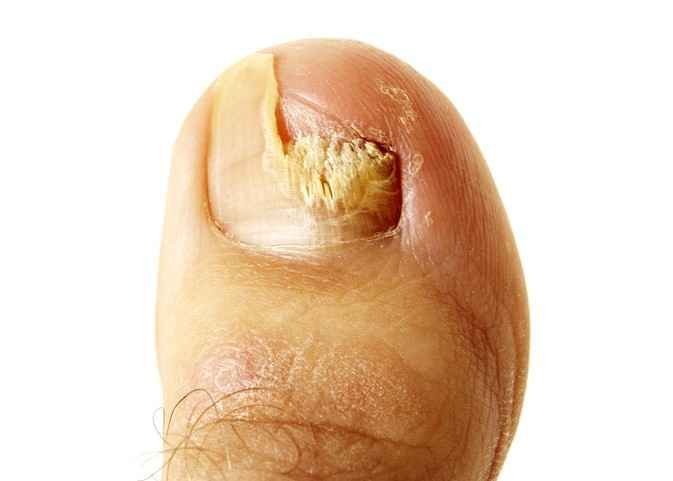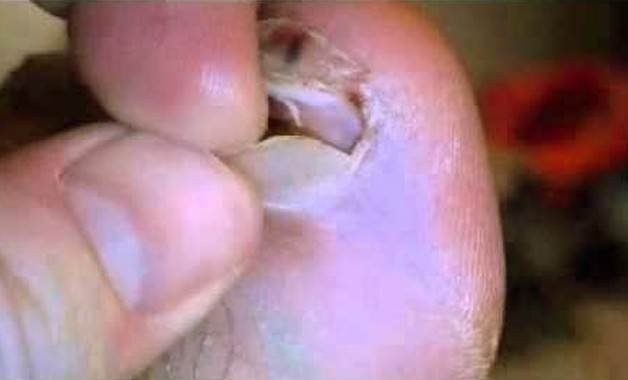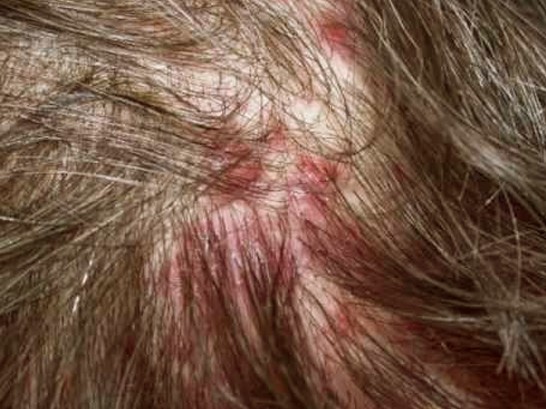What causes Toenail to fall off?
 Picture 1: Toenail falling off
Picture 1: Toenail falling off
A sign of injury can be the presence of bruises on the skin or blood clots below the toenail, which is named subungual hematoma. If this happens, a medical professional should remove the blood. When we suffer a subungual hematoma, we experience painful bleeding under the toenail, which should not be considered as a bruised nail, which does not hurt.
Therefore, the toenail falling off can be secondary consequence of an infection by fungi that affect the nails. It can also be a consequence of systemic diseases, such as liver or kidney failure, syphilis, and AIDS, and it can also be caused by the use of chemotherapy to combat various types of cancer. The toenail falling off can also be due to injuries caused by an accident, blow, or by footwear. Lastly, toenail falling off may be due to stress: Medical specialists claim that stress, chemical or environmental contamination, also nutrient deficiencies in food are the major causes of nail diseases, and onychoptosis is one of them.
Treatment
Treatment if the lesion is due to fungi
 Picture 3 – Toenail falling off due to fungus
Picture 3 – Toenail falling off due to fungus
We will clean the area properly with soap and warm water. We will keep the area dry. We will apply an antiseptic (benzalkonium chloride) once or twice a day. The new toenail should grow in the next two months. If the nail does not grow back, we will consult a podiatrist. He can prescribe us a topical cream to treat the infection, or an oral medication if it needed. In very rare cases we may need surgery to remove the nail or an infected area.
Injury Treatment
 Picture 2 – Injured Toenail falling off
Picture 2 – Injured Toenail falling off
In most cases where the toenail falls due to an injury, it will grow back after a few months. During the regrowth process, we will try to apply pressure to the injured area. We will avoid wearing pointy shoes or high heels. We will keep our feet dry. If the nail does not grow again, or if it grows painfully or unsightly, we will consult a medical professional.
Home Remedies
The first thing to do in case of toenail falling off is to identify the reason, since if it is by fungi, it will be necessary to visit a podiatrist, in order to indicate the appropriate treatment, and also in case it is a pathology, such as Psoriasis. A toenail that falls from a hit or injury is quite common, and it is not serious. Once the nail has been dropped, we must clean the area with a mild soap and warm water. It is very important to keep the affected area dry; we can place a band that is not too tight, to avoid friction, also avoid the area is too exposed.
If we suffer pain is advisable to take some analgesic, and if the toenail falls off because of a fungus it is necessary to apply an antiseptic to prevent the proliferation. When the nail has not yet fallen, we can feel a pressure on the finger because of the blood under the toenail, which will dry over time, and then we can remove it; it will also disappear as the new nail begins to grow. If the finger has an inflammation, it is advisable to soak it in an infusion of chamomile that is not too hot. Another home remedy in case of infection is to place our damaged finger, or both feet, in salt water.
It is very common that the nail begins to grow meanwhile the first one has not completely fallen off. In this case, we should control the growth; we can smooth the boundary between one and the other, so it grows evenly. In case we notice that the toenail does not grow again, it is necessary to visit the physician and/or podiatrist: it is usually a very rare case, and surgery is necessary for the toenail to come out again.
Some recommendations for a proper care of the feet and nails:
- To wear comfortable shoes in order to our foot can breathe and it is not tight.
- To wear comfortable sandals in case we use public showers in sport clubs, gyms etc.
- To wash our feet daily, making sure to dry them well.
- To keep toenails short to prevent them from getting stuck.
- To use specific foot talcum.
- To sanitize the instruments for the pedicure every time we use them.
Should I be worried?
In some cases, low percentage, the toenails state can give evidence of oncological diseases. Medical experts recommend that patients visit for any alteration in the color or shape of the nail. Nails are very easy to examine, but the doctor should be well informed of these signs: Dark spots, thin white lines, yellowish color, skin separation, peeling, lack of growth, excessive curvature, thinning almost reaching transparency, ends lifting, bleeding, edges inflammation, or pink bands at the edges, are characteristic signs that something is wrong, and it is advisable to consult our doctor.
Partial detachment on the edges of the toenail (Onycholysis) may advertise hypothyroidism or hyperthyroidism, myeloma, anemia, lung cancer or diabetes. In the other hand, toenail falling off (Onychoptosis) helps identify febrile illnesses, poorly controlled diabetes, excessive stress, pneumonia, psoriasis, or adverse drug reactions.
Alarm Signs
When the toenail becomes a concave shape with lifting at the ends, it may indicate anemia, coronary disease, hypothyroidism or malnutrition. If the appearance is bleeding under the nail caused by the rupture of the vessels located longitudinally, a trauma or an internal cause should not be ruled out. A greater curvature of the nail, accompanied by an excessive growth of the connective tissue and swelling of the whole finger, is an alteration known as Hippocratic fingers, related to systemic diseases. It is a disorder in which the surface of the nails reaches an angle greater or equal to 180º; it is usually difficult to diagnose it. It is usually a sign of pulmonary, cardiac, hepatic, gastrointestinal and renal insufficiency.




